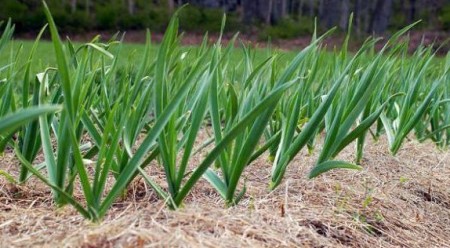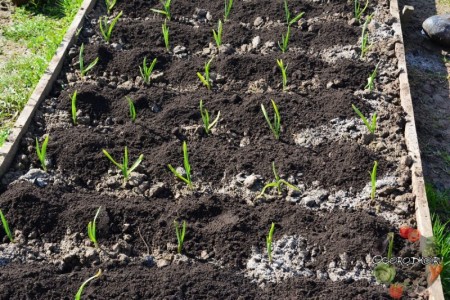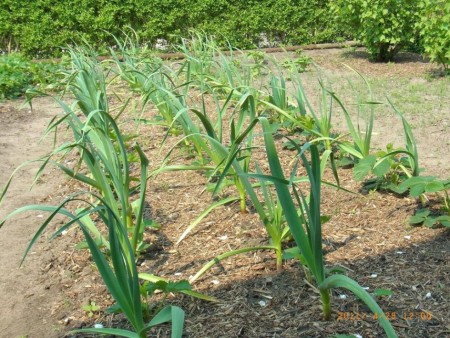Feeding garlic most often means watering it with various means when the leaves turn yellow in the spring. It is not right. Fertilizing should be aimed at improving nutrition and increasing crop productivity. It is carried out several times during the growing season.
Nutritional requirements of garlic
Depending on the phase of development, the requirements of garlic for mineral nutrition elements change.
- During the germination phase, garlic requires a lot of nitrogen, which promotes rapid growth of tops.
- As leaves grow, the plant's need for potassium and phosphorus increases.
- When forming arrows and setting bulbs, phosphorus consumption is further enhanced, and the need for nitrogen is sharply reduced.
Fertilizers must fully provide plants with nutrients and be applied in a timely manner and in the required quantities.
Fertilizing winter garlic
Fertilizers for winter garlic are applied 2-3 weeks before planting and the following year in the form of fertilizing. In autumn, the beds are filled with completely decomposed compost or humus at the rate of 6-7 kg/m². Mineral fertilizers are also applied during digging: superphosphate 40 g/m² and potassium sulfate 20-30 g/m².
Instead of phosphorus and potassium, you can use a complex fertilizer for onions and garlic containing nitrogen-phosphorus-potassium (NPK) 17:17:17.
Nitrogen fertilizers are not used in the fall, since they are very unstable and are quickly washed into the lower layers of the soil.
Manure should not be applied directly to planting, as it enhances the growth of leaves to the detriment of the formation of heads. It is used only for garlic predecessors. In this case, the crop yield increases by 10-15%.
During the growing season, winter garlic is fertilized 3 times.
First feeding carried out in the germination phase in late April-early May. At this time, plants experience a lack of nitrogen; therefore, without waiting for the leaves to turn yellow, nitrogen fertilizers are applied. Most often, garlic is fed with urea, ammonium sulfate or ammonium nitrate.
Urea - the most concentrated nitrogen fertilizer (contains 46% nitrogen). Usually liquid feeding is done: 1 tbsp. a spoonful of fertilizer is dissolved in 10 liters of water and the plants are watered.If the soil is very wet, then urea is applied dry into the rows and sealed.
Ammonium sulfate - 3 tbsp. spoons per 10 liters of water, water the plants at the root. Fertilizer acidifies the soil, so it is used with caution on acidic soils.
Ammonium nitrate is a physiologically acidic fertilizer and is usually not applied on acidic soils. On neutral soils, use 2 tbsp for fertilizing. spoons per 10 liters of water. Water the garlic at the root.
If the weather is cold and rainy, then the plants are sprayed with the same preparations, but the dose is reduced by half to avoid leaf burns.
It should be taken into account that with an overdose of nitrogen fertilizers, the bulbs are formed into small, loose ones and are not stored for a long time. Nitrogen can also accumulate in leaves in the form of nitrates.
Second feeding of garlic- late May-early June. By this time, the need for nitrogen is significantly reduced, and the need for potassium and phosphorus increases. Therefore, a complete complex fertilizer is used - nitrophoska (NPK content 11:10:11), or nitroammophoska (13:19:19). Apply 25-30 g/m2 to moist soil, followed by incorporation. You can make a liquid fertilizer by diluting 2 tbsp. spoons of fertilizer in 10 liters of water.
Third feeding takes place at the end of June. During this period, the need for nitrogen in garlic completely disappears. Plants are fed with superphosphate, making an extract from the fertilizer: 100 g of double superphosphate is crushed and poured with hot water. They insist for a day. Then 3-4 tbsp. spoons of the extract are diluted in 10 liters of water and watered over the beds with garlic.
Fertilizing spring garlic
When planting spring garlic, the soil for it is prepared in the fall and the same substances are added as for winter garlic. During the growing season, 3 additional feedings of spring garlic are carried out.Since it does not suffer from nitrogen deficiency, there is no need to apply nitrogen fertilizers on your own. Plants have enough nitrogen contained in complex fertilizers.
First feeding. It is carried out during the period of top growth, when 4-5 leaves appear. Complex fertilizers are applied: nitroammophoska, nitrophoska (2 tablespoons/10 l). If the soil was limed in the fall, then additionally feed the garlic with potassium sulfate (1 tablespoon per bucket of water), since the calcium contained in lime displaces potassium into the lower soil layers.
Second feeding - late June-early July. During this period, spring garlic needs nitrogen in small quantities, so the crop is again fed with nitroammophoska or nitrophoska. You can do both dry and liquid root feeding.
Third feeding takes place at the end of July. Plants are watered with superphosphate extract.
Feeding garlic with folk remedies
These include: adding ash and ammonia to the garlic, fertilizing with yeast, manure, and herbal infusion.
How to feed garlic with ash
Wood ash is an excellent potassium-lime fertilizer. The ash of deciduous trees contains more potassium, and that of coniferous trees contains more phosphorus; in addition, it contains a significant amount of calcium and various trace elements. There is no nitrogen in it.
Add ash in the fall for digging at 400-500 g/m2. It reduces soil acidity and is much gentler than lime.
In summer, it is applied as an infusion instead of mineral fertilizers in the second feeding. To prepare the infusion, 1.5-2 cups (200 g) of ash are poured into 10 liters of water and left for 3-5 days, stirring thoroughly several times a day. 1 glass of the prepared infusion is diluted in 10 liters of water and the beds with garlic are fed.
You can also add it in dry form, but it must be sealed, otherwise it will be blown away by the wind. When fertilizing with ash, other fertilizers cannot be applied. It should be used very carefully on alkaline soils.
Peat ash is not added to the soil because it contains a large amount of iron. This ash has a brown (rusty) color.
Is it worth feeding garlic with ammonia?
Ammonia is a 10% solution of ammonia in water containing 18% nitrogen. It has a pungent odor and is very volatile. For feeding 2 tbsp. spoons of ammonia are dissolved in 10 liters of water and watered between the rows. The solution is used immediately after preparation, otherwise the ammonia will evaporate.
After fertilizing, the row spacing is sprinkled with earth to prevent volatilization. Or, immediately after applying the fertilizer, carry out abundant watering with clean water so that ammonia is washed from the surface to a depth of 20-25 cm. Fertilizing is carried out at the seedlings (for winter garlic) and in the phase of 4-5 leaves (for spring garlic).
Plants respond very well to the application of ammonia, but its main disadvantage is its extremely high volatility.
Yeast feeding
This type of feeding has become widespread recently. Baker's yeast (fresh or dry) is poured into 10 liters of water, to which 300-400 g of bread crumb, grass or sugar are added. Water with freshly prepared solution.
Yeast is rich in proteins and vitamins, but does not contain substances needed by plants. Therefore, their use as a top dressing is completely useless.
Application of organic fertilizers
The most commonly used organic fertilizers are manure and compost.
Manure has a gentler and longer-lasting effect on plants compared to mineral fertilizers.But due to the high nitrogen content in it and the long-term effect, garlic gains green mass throughout almost the entire growing season and does not set heads. In this regard, feeding garlic with manure not carried out.
On infertile soils poor in organic matter in the spring, it is permissible to water the garlic with compost extract. To prepare it, pour a shovelful of mature compost into a bucket and fill it with water. Leave for 3-4 days, stirring regularly, until the compost settles. This extract is poured over the garlic. Nitrogen fertilizers are not used in this case. Compost, like manure, acts gently and slowly on plants.
How to feed garlic with herbal infusion
Herbal infusions are a valuable fertilizer, since the green mass contains a lot of nitrogen. To prepare it, a large container (barrel, bathtub) is filled 2/3 with fresh chopped weeds (plantain, nettle, dandelion, gooseberry, etc.). The grass should not be compacted; air should penetrate freely between the grass.
The container is filled with water and left in the open air for 10-15 days, during which time the fermentation process occurs. The infusion is thoroughly mixed throughout the fermentation period. When the process ends, the suspension settles to the bottom, and the infusion becomes transparent. Garlic is fed with herbal infusion in the first half of the growing season, when it needs nitrogen. For irrigation, 1 liter of infusion is diluted in 10 liters of water.
Fertilizing garlic should be done strictly in recommended doses. An excess of nutrients is just as harmful to plants as their deficiency.
You may be interested in reading other articles about growing garlic:
- Why do garlic leaves turn yellow and what needs to be done to correct the situation.
- Description of varieties of winter and spring garlic.
- Planting and caring for winter garlic.
- Rules for planting and caring for spring garlic.
- When to harvest and how to preserve garlic in winter.
- How to get large heads of garlic





 CUCUMBERS NEVER GET SICK, I'VE BEEN USING ONLY THIS FOR 40 YEARS! I SHARE A SECRET WITH YOU, CUCUMBERS ARE LIKE THE PICTURE!
CUCUMBERS NEVER GET SICK, I'VE BEEN USING ONLY THIS FOR 40 YEARS! I SHARE A SECRET WITH YOU, CUCUMBERS ARE LIKE THE PICTURE! You can dig a bucket of potatoes from each bush. Do you think these are fairy tales? Watch the video
You can dig a bucket of potatoes from each bush. Do you think these are fairy tales? Watch the video
 How our fellow gardeners work in Korea. There is a lot to learn and just fun to watch.
How our fellow gardeners work in Korea. There is a lot to learn and just fun to watch. Eye trainer. The author claims that with daily viewing, vision is restored. They don't charge money for views.
Eye trainer. The author claims that with daily viewing, vision is restored. They don't charge money for views. A 3-ingredient cake recipe in 30 minutes is better than Napoleon. Simple and very tasty.
A 3-ingredient cake recipe in 30 minutes is better than Napoleon. Simple and very tasty. Therapeutic exercises for cervical osteochondrosis. A complete set of exercises.
Therapeutic exercises for cervical osteochondrosis. A complete set of exercises. Which indoor plants match your zodiac sign?
Which indoor plants match your zodiac sign? What about them? Excursion to German dachas.
What about them? Excursion to German dachas.